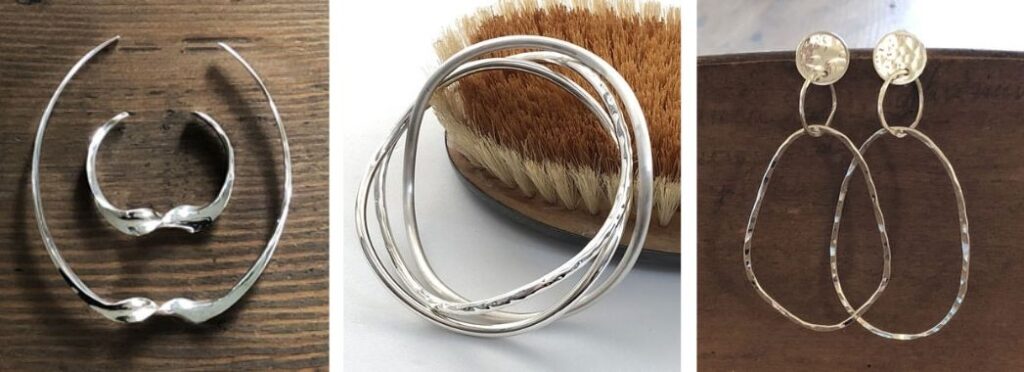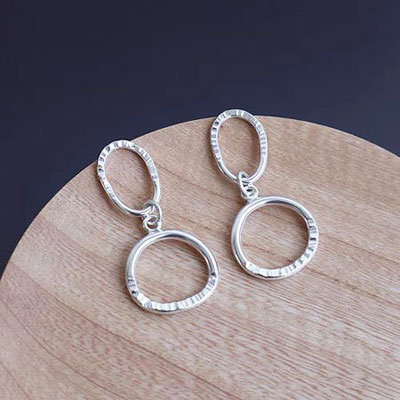Silver jewellery is broad term and it is good to know exactly what you buy.
Silver can be a reference to the metal or to the colour. It can be pure silver, sterling silver, plated or rolled silver or a base metal with a silver colour. There is no right or wrong in what you choose as there is a place and purpose for everything. Cost, tradition, intended use and fashion trends dictate the choice of silver. Fashion jewellery or costume jewellery will often follow quickly changing fashion trends so cost is an important factor allowing the consumer to renew their jewellery as often as the fashion shifts. Old cultures may have traditional methods of creating jewellery and may use silver-like metals which is then carried on to today’s pieces. Silversmiths and artisans who use silver as an artform may choose pure silver or sterling silver because of its purity and longevity.
When buying a piece of silver jewellery, you should know what it is made of. This will determine how well it wears and how you should look after it. For advice on how to care for your jewellery, take a look at our Silver Care page.
When a silver piece is described as sterling silver, it means it is silver all through. If a piece only has a top layer of sterling silver, it is described as silver plated.
The jewellery at Crowded Silver is mainly sterling silver, which means it is solid sterling silver, not plated silver. You will find an accurate description for each of our jewellery pieces on their product page. Some of our pieces are gold plated on top of solid sterling silver. Our range by Milena Zu is different in that most pieces are from other base metals such as brass, copper and stainless steel and often plated with silver or gold….but again…each page will give you an accurate description of the metal used.
Let’s give you a quick explanation of each silver term. As the majority of our jewellery is made from sterling silver, we’ll begin with that.
Sterling Silver
Sterling silver is the most commonly silver alloy used in fine jewellery. It has been used for centuries and is a standard worldwide grade. Sterling silver is 92.5% silver and 7.5% copper. The addition of copper makes sterling silver more durable and more wearable.
Sterling silver jewellery is typically hypoallergenic (it doesn’t irritate skin easily) and is workable and has a beautiful lustre and shine. Sterling silver is often stamped with 925 which represents the percentage of pure silver.
Fine Silver
Fine silver is the purest silver form of silver and is also referred to as pure silver. It is made of 99.9% silver with the balance being traces of impurities. Fine silver is more lustrous and whiter than other silver types and doesn’t tarnish much. However, it is very soft and can be difficult to shape into delicate forms and is not considered strong enough for jewellery.
Pure silver is mainly used for bullion bars for international trading and investment. Fine silver is often stamped 999 or 999FS.
Silver Plated
If your jewellery is referred to as silver plated, it means that a thin layer of sterling silver has been coated over the top of cheaper base metal. The amount of silver used is very small and aims to keep the price point down to make the jewellery more affordable.
Gold plated jewellery as opposed to solid gold has the same purpose of keeping the price low. However, gold can be plated over base metal or over sterling silver. Any gold plated pieces in our shop will have an accurate description of the metal used.
As silver plating is a thin layer, it may rub off over time especially for rings, bracelets and necklaces which rub against your skin. Silver earrings on the other hand will keep their silver layer for much longer. When you care for silver plated jewellery, you need to be more gentle and avoid rubbing.
Rolled or Filled Silver
Rolled silver sits somewhere between silver plated and sterling silver. This type of jewellery has a thicker layer of sterling silver coating than plated silver. Rolled silver is not a different silver alloy, but rather a base metal with a heavier layer of sterling silver around it.
Silver filled jewellery often contains about 5 – 10% silver that has been fused to the base metal as opposed to electroplated silver plating.
Rolled silver is very durable and will stand up to wear and tear compared to plated silver but is also more expensive due to its higher silver content.
Nickel Silver
This metal is mainly used for costume jewellery where the end price point is very important. Nickel silver has no silver content and the name refers more to its silver colour. Nickel silver is usually made from a blend of copper, nickel and zinc and is an easy and inexpensive metal to work with. It can be lustrous, bright and looks similar to sterling silver. Nickel can however cause an allergic reaction and has therefore been phased out as an alloy in sterling silver. When nickel tarnishes, it may give you a greenish discoloration on your skin.
Tribal Silver
Tribal silver refers more to the style of jewellery than the metal used. We associate tribal pieces with beautiful, intricate designs made by artisans and based on old cultures and traditions.
The metal used is sometimes described as ‘white metal’ which may have a high amount of silver or none at all. White metal is an alloy, ie a combination of metals, and this can contain silver, copper and nickel in varying amounts.




